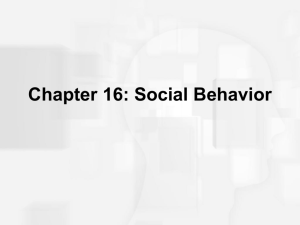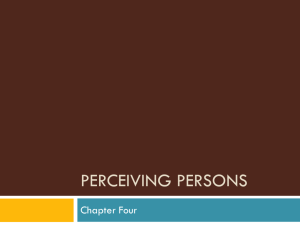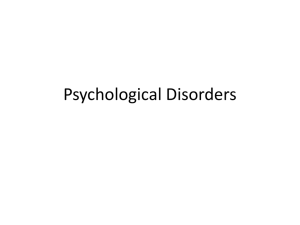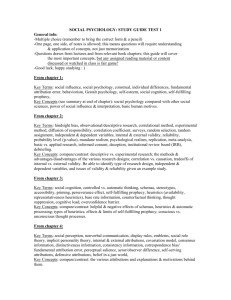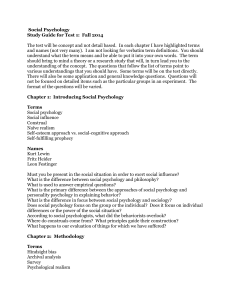Attribution - People Server at UNCW
advertisement
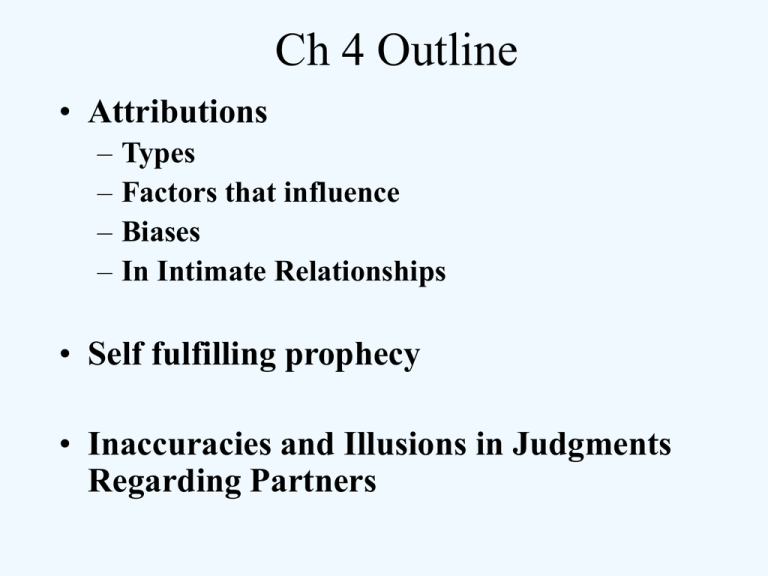
Ch 4 Outline • Attributions – – – – Types Factors that influence Biases In Intimate Relationships • Self fulfilling prophecy • Inaccuracies and Illusions in Judgments Regarding Partners Social Cognition • Social psychology is the study of how people influence our behavior • Social cognition focuses on the individual patterns and biases in our perceptions about people’s behavior Attribution • Defined-process we use to assign causes to behavior (ours and other’s) • Function-We tend to explain and understand behavior and the events that impact our lives • Types : Internal vs External Stable vs Temporary Types of Attribution Internal attributions based on individual’s dispositions, traits, abilities, and feelings External attributions based on situational variables that everyone is influenced by Attributions: Why is My Spouse Late? Stable Internal External “S/he is inconsiderate” “Her/His boss often asks her/him to do something at quitting time” Temporary “S/he is tired” “Car trouble” How do we decide whether behavior is due to internal or external causes? • Consistency – how the person’s behavior varies over time in same setting (Is s/he late for family dinner often?) • Consensus – how the person’s behavior compares with other’s behavior in same setting (Are others late for family dinner?) • Distinctiveness – how the person’s behavior varies across settings (Is s/he late often for other activities?) When do we spend a lot of time thinking about attributions? • When someone’s behavior affects us, especially if the effect is negative (Weiner, 1985) Biases in Attribution • Fundamental Attribution Error – we tend to make internal attributions for other’s behavior (“He was late because he is lazy or tired.”) • Actor-Observer Bias – we tend to make external attributions for our behavior (“He was late because he is lazy, BUT I was late because my alarm didn’t go off.”) Biases in Attribution • Self-Serving Bias – we tend to attribute our success to internal factors and failure to external factors (“I got an A in Psy because I am smart, I got a D in Math because the tests were unfair.”) Contextual Model of Attribution Partner A’s behavior Partner A’s processing Partner B’s processing Partner B’s behavior Attribution Processing in Intimate Relationships (Holtzworth-Munroe & Jacobsen, 1985) • Women spend more time processing attributions than men, regardless of how happy they are in the relationship • Men in happy relationships invest much less time processing attributions than men in unhappy relationships Attribution Processing in Intimate Relationships (Holtzworth-Munroe & Jacobsen, 1985: Brehm & Kassin, 1990) Contextual Model of Attribution Partner A’s Good or Bad Deed Partner B’s behavior External/Internal; Temp/Stable processing Partner A’s processing Partner B’s behavior Attributions Affect Behavior (Bradbury & Fincham, 1992) • Distress-maintaining attributions predict less effective conflict resolution behavior (high rates of hostile and rejecting behavior) • Distress-maintaining attributions make one likely to – Reciprocate partner’s negative behavior – Fail to respond to partner’s positive behavior Contextual Model of Attribution Partner A’s Bad deed behavior Good deed Partner A’s processing Partner B’s External, temporary processing Internal, stable No deed Bad deed Partner B’s behavior Attachment as Context Variable • Securely attached people more likely to make relationship-maintaining attributions – Remember positive past events – Open to new information – Accurate judges of partner’s thoughts & feelings • Insecurely attached people more likely to make distress-maintaining attributions Schemas as Context Variables • We all have a relationship schema or set of beliefs and expectations about how a relationship should be • Romantic beliefs predict love, but not relationship success (Sprecher & Metts, 1989) – “Each of us has only one true love” • Dysfunctional beliefs predict dissatisfaction and dissolution in intimate relationships (Eidelson & Epstein, 1981, 1982) – “Disagreements are destructive” Attribution in Family • Consensual validity-unified consensus information (“you are the only one here acting differently”) of family members about 1 member is powerful influence on self-concept – Can lead to scapegoating-one member is alienated and blamed for all family’s problems, no one is there to contradict – Can lead to gaslighting-members consistently call into question 1 member’s perception of self and reality Self-fulfilling Prophecies • We follow cues about how we are expected to act Self-fulfilling Prophecies • Men expected to talk to “hot babe” or “plain Jane”, treated women accordingly • Low self-esteem people elicit rejection Attributions become Selffulfilling Prophecies • In close relationships, we maintain our reps – Unhappy relationship over time = Good deeds decrease and bad deeds increase (“She never notices when I’m on time so why should I hurry?!”) – Happy relationship over time = Good deeds increase and bad deeds decrease (“He thinks I’m a great cook so I’ll make my special lasagna tonight!”) How Accurately Do We Know Our Partners? • We overestimate how similar we are to our partners – Especially anxiously attached • We overestimate how well our partners understand us and agree with us • Perceived similarity associated with relationship satisfaction What Factors Affect Accuracy? • Type of relationship – Living together leads to greater accuracy than length of acquaintance – Married people are more accurate than daters and friends • Newlyweds more accurately infer partner’s thoughts than “oldyweds” What Factors Affect Accuracy? • Perceiver traits – Intelligence and open-mindedness predict accuracy – Secure attachment predicts accuracy Positive Illusions in Intimate Relationships • We judge partners in idealized way – We emphasize positive traits – If we are aware of faults, we perceive them as less important than others do • Relationships with positive illusions associated with greater satisfaction, love, and trust Why are we the “most knowledgeable but least objective” – Ideals become mixed up with reality – Illusions make us feel better about ourselves – Illusions maintain commitment

